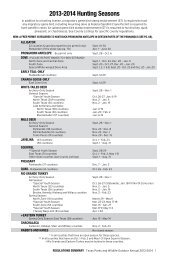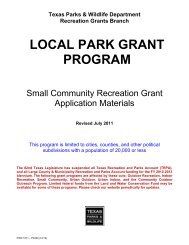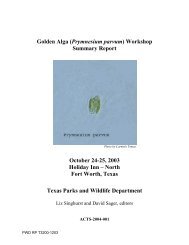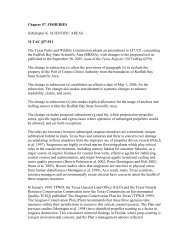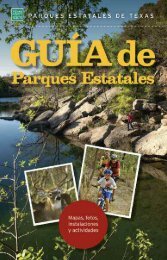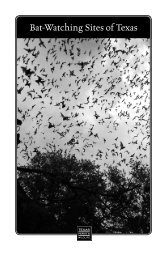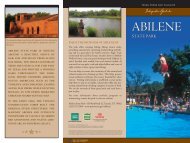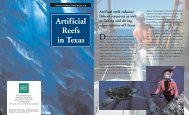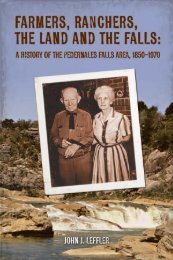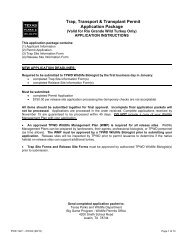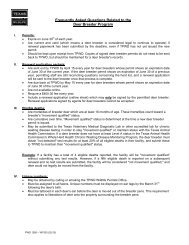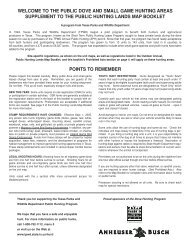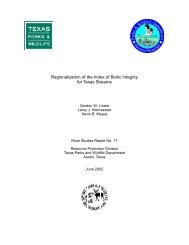Interpretive Guide to Bastrop and Buescher State Parks
Interpretive Guide to Bastrop and Buescher State Parks
Interpretive Guide to Bastrop and Buescher State Parks
You also want an ePaper? Increase the reach of your titles
YUMPU automatically turns print PDFs into web optimized ePapers that Google loves.
THE LOST PINES<br />
ARE IN YOUR HANDS<br />
The Lost Pines area continues <strong>to</strong> draw people <strong>and</strong> has become<br />
a major <strong>to</strong>urist destination. You can help TPWD conserve the<br />
resources of <strong>Bastrop</strong> <strong>and</strong> <strong>Buescher</strong> <strong>State</strong> <strong>Parks</strong>. Here’s how:<br />
Protect the integrity of his<strong>to</strong>ric CCC structures, they are part<br />
of our heritage, please use them respectfully.<br />
Learn more about both parks with available literature at the<br />
park headquarters.<br />
Tread lightly on the<br />
natural resources by<br />
staying on the trails<br />
<strong>and</strong> not littering.<br />
Take advantage of<br />
the interpretive<br />
activities including<br />
his<strong>to</strong>ric <strong>to</strong>urs of the<br />
CCC structures,<br />
evening presentations<br />
<strong>and</strong> guided<br />
nature hikes.<br />
Become an active supporter<br />
by joining the<br />
Friends of the Lost<br />
Pines, or make a<br />
donation <strong>to</strong> the park.<br />
Respecting the resources of the Lost Pines is necessary for<br />
your gr<strong>and</strong>children <strong>to</strong> experience the natural beauty you<br />
enjoy <strong>to</strong>day. Please join us in this effort.<br />
<strong>Bastrop</strong> <strong>State</strong> Park • Box 518, <strong>Bastrop</strong>, TX 78602-0518<br />
(512) 321-2101 • www.tpwd.state.tx.us/park/bastrop/<br />
Proud Sponsor of Texas <strong>Parks</strong> <strong>and</strong> Wildlife Programs<br />
In accordance with Texas <strong>State</strong> Deposi<strong>to</strong>ry Law, this publication is available at<br />
the Texas <strong>State</strong> Publications Clearinghouse <strong>and</strong>/or Texas Deposi<strong>to</strong>ry Libraries.<br />
© 2004 TPWD. PWD BR P4505-043P (7/04) Printed on recycled paper.<br />
texas parks <strong>and</strong> wildlife<br />
<strong>Interpretive</strong> <strong>Guide</strong> <strong>to</strong>:<br />
BASTROP<br />
AND BUESCHER<br />
STATE PARKS<br />
L O S T<br />
TH E<br />
PI N E S<br />
WEL C OME T O<br />
THE LOST PINES<br />
O F TEXAS, THE<br />
H O M E O F<br />
BA S T R O P A N D<br />
B U E S C H E R<br />
STATE<br />
PARKS.<br />
THE U N IQ U E<br />
SETTING OF BOTH PARKS EVOKES A<br />
SENSE OF MYSTERY, AS THE ISOLATED<br />
FOREST OF LOBLOLLY PINES SEEMS<br />
TO BE OUT OF PLACE. BEAUTIFUL<br />
STRUCTURES BUILT BY THE CCC<br />
SEE M T O GRO W FROM THE<br />
SURROUNDING LANDSCAPE. STONE<br />
CABINS, BRIDGES AND STUNNING<br />
CRAFT SMANSHIP MAKE THESE<br />
PARKS AN HISTORIC TREASURE.<br />
✯✯ ✯ ✯✯<br />
<strong>Bastrop</strong> <strong>and</strong> <strong>Buescher</strong><br />
<strong>State</strong> <strong>Parks</strong> were<br />
acquired from the cities of<br />
<strong>Bastrop</strong> <strong>and</strong> Smithville <strong>and</strong><br />
from private l<strong>and</strong> donations.<br />
In the 1930s the <strong>Buescher</strong><br />
family gave 636 acres for a<br />
state park. Since its dedication in 1937, <strong>Bastrop</strong> <strong>State</strong><br />
Park has grown <strong>to</strong> approximately 5,800 acres of pine<br />
laden rolling hills while <strong>Buescher</strong> compliments this preserve<br />
with an additional 1,017 acres.<br />
Through time people have recognized the value of this<br />
abundant natural resource. In addition <strong>to</strong> the presence of<br />
critical resources, a convenient river crossing made this a<br />
likely place for early settlement. The important Spanish<br />
travel route known as El Camino Real traversed through<br />
the area <strong>and</strong> aided in the early colonization of Texas. The<br />
<strong>to</strong>wn of <strong>Bastrop</strong>, formerly known as Mina when established<br />
in 1832, is believed <strong>to</strong> be one of the oldest <strong>to</strong>wns in<br />
Texas. The natural resources of the area were important<br />
<strong>to</strong> regional development; timber harvest of the loblolly<br />
pines fueled construction in nearby Austin <strong>and</strong> San<br />
An<strong>to</strong>nio. Some of the <strong>Bastrop</strong> timber was exported as far<br />
as northern Mexico. Later, the Civilian Conservation<br />
Corps (CCC) came <strong>and</strong> constructed <strong>Bastrop</strong> <strong>and</strong><br />
<strong>Buescher</strong> <strong>State</strong> <strong>Parks</strong>.
B A S T R O P A N D B U E S C H E R S T A T E P A R K S<br />
ROOSEVELT’S FOREST ARMY<br />
Imagine being 20<br />
years old <strong>and</strong> without<br />
enough money<br />
<strong>to</strong> buy your next meal.<br />
This was the case for<br />
many young men in the<br />
early 1930s during the<br />
Great Depression.<br />
President Franklin D.<br />
Roosevelt created a public works organization known as<br />
the Civilian Conservation Corps (CCC) in an effort <strong>to</strong> put<br />
young men <strong>to</strong> work, <strong>to</strong> conserve the nation’s natural<br />
resources, create public recreational areas <strong>and</strong> <strong>to</strong> help boost<br />
the economy.<br />
In 1933 companies #1805 <strong>and</strong> #1811 arrived at <strong>Bastrop</strong><br />
<strong>and</strong> <strong>Buescher</strong> <strong>State</strong> <strong>Parks</strong> <strong>to</strong> transform the over-cut pine<br />
forest in<strong>to</strong> a scenic wonder by seeding, transplanting <strong>and</strong><br />
clearing the tangle of brush <strong>and</strong> fallen timber. These<br />
recruits enrolled for a six-month period <strong>and</strong> were paid<br />
$30 per month, with $25 of the monthly wage being sent<br />
back home <strong>to</strong> the CCC worker’s family.<br />
GROW I N G<br />
F RO M T HE G RO U ND<br />
In 1933, the<br />
National Park<br />
Service (NPS), the<br />
CCC <strong>and</strong> the Texas<br />
<strong>State</strong> <strong>Parks</strong> Board<br />
(now the Texas<br />
<strong>Parks</strong> <strong>and</strong> Wildlife<br />
Department) joined<br />
h<strong>and</strong>s <strong>to</strong> design <strong>and</strong><br />
construct buildings <strong>and</strong> facilities in many Texas parks. The<br />
architect of <strong>Bastrop</strong> <strong>State</strong> Park, Arthur Fehr, followed National<br />
Park Service design principles that suggested harmony with the<br />
surrounding l<strong>and</strong>scape of rolling hills <strong>and</strong> pine forests <strong>and</strong> use of<br />
native materials for construction. The s<strong>to</strong>ne cabins at <strong>Bastrop</strong><br />
appear <strong>to</strong> grow out of the ground like a natural outcrop. The<br />
same non-intrusive design elements were followed for dams,<br />
culverts, bridges <strong>and</strong> fences. Similar design concepts can be seen<br />
in other parks around the nation. <strong>Bastrop</strong>’s refec<strong>to</strong>ry is a showplace<br />
of CCC craftsmanship. Cedar, oak, walnut <strong>and</strong> pine<br />
indigenous <strong>to</strong> the park <strong>and</strong> red s<strong>and</strong>s<strong>to</strong>ne quarried nearby come<br />
<strong>to</strong>gether in an attractive s<strong>to</strong>ne structure featuring carved mantles,<br />
roof beams <strong>and</strong> h<strong>and</strong>made furniture.<br />
In 1997, <strong>Bastrop</strong> <strong>State</strong><br />
Park was awarded<br />
National His<strong>to</strong>ric<br />
L<strong>and</strong>mark status, due<br />
largely <strong>to</strong> the enduring<br />
craftsmanship <strong>and</strong><br />
l<strong>and</strong>scape work done<br />
in the park by the CCC.<br />
It is one of only five CCC<br />
parks in the nation with<br />
this recognition.<br />
ARE THE LOST PINES REALLY LOST?<br />
People have long wondered why the pines are here. The stark<br />
contrast of the deep s<strong>and</strong>y soils <strong>and</strong> pine trees, compared with<br />
the surrounding oak savanna <strong>and</strong> grassl<strong>and</strong> prairie, begs the<br />
question: Are the Pines really lost?<br />
Legend has it that American Indians traveled here from East<br />
Texas <strong>and</strong> planted seedlings <strong>to</strong> remind them of the home they<br />
left behind. Other myths claim that the pines got “lost” or that<br />
they were once part of a continuous stretch of loblolly forest<br />
from the east.<br />
The Lost Pines are significant in that<br />
they represent the westernmost st<strong>and</strong><br />
of loblolly pine trees in the<br />
PINEY<br />
WOODS<br />
United <strong>State</strong>s. Separated<br />
LOST<br />
from the East Texas Pineywoods<br />
PINES<br />
by nearly 100 miles, pollen records<br />
indicate the pines have persisted in<br />
this area for over 18,000 years. S<strong>and</strong>y <strong>and</strong><br />
gravely soils with a sub-surface layer of water preserving<br />
clay help <strong>to</strong> create an environment where loblolly pines can<br />
flourish. Over time the climate became drier but the local s<strong>and</strong>y<br />
aquifer-laced soils provided conditions for them <strong>to</strong> thrive. The<br />
pines have become genetically unique, having adapted <strong>to</strong> 30%<br />
less rainfall than loblollies from<br />
East Texas <strong>and</strong> adjacent states.<br />
Over 75,000 acres of loblolly<br />
pines, known as the Lost Pines<br />
ecosystem, lie scattered across<br />
sections of five counties on the<br />
Texas Coastal Plain. A portion<br />
of this magnificent pine forest is<br />
located in <strong>Bastrop</strong> <strong>and</strong> <strong>Buescher</strong><br />
<strong>State</strong> <strong>Parks</strong>.<br />
An Isl<strong>and</strong> of Diversity<br />
<strong>Bastrop</strong> <strong>and</strong> <strong>Buescher</strong> <strong>State</strong> <strong>Parks</strong> lie within the ecological<br />
region known as Post Oak Savannah. A mosaic of pine,<br />
oaks, shrubs, grassl<strong>and</strong> <strong>and</strong> mixed flowering plants create<br />
a diverse environment important <strong>to</strong> many species of<br />
wildlife including the pileated woodpecker, the largest of<br />
the woodpeckers. The seasonally moist s<strong>and</strong>y soils of the<br />
Lost Pines provide critical habitat for the largest remaining<br />
population of the endangered Hous<strong>to</strong>n <strong>to</strong>ad.<br />
The Hous<strong>to</strong>n <strong>to</strong>ad was<br />
recognized as an endangered<br />
species in 1970.<br />
Loss of habitat in its<br />
his<strong>to</strong>ric range, largely<br />
due <strong>to</strong> urbanization, has<br />
caused a marked decline<br />
in populations of this<br />
species in recent decades.<br />
Protecting the Lost Pines<br />
Over the past 150 years, human activities such as logging,<br />
farming <strong>and</strong> fire suppression have changed the natural<br />
environment. In recent years, population growth <strong>and</strong><br />
economic development have further fragmented the Lost<br />
Pines ecosystem. TPWD has developed<br />
new strategies <strong>to</strong> protect this unique<br />
resource. These include l<strong>and</strong> acquisition,<br />
public education <strong>and</strong> prescribed fire.<br />
Prescribed burning is necessary <strong>to</strong> reduce<br />
large fuel loads that can cause wildfires.<br />
These purposefully set <strong>and</strong> moni<strong>to</strong>red fires<br />
increase the diversity of native plants <strong>and</strong><br />
grasses thus improving the overall health <strong>and</strong><br />
viability of the Lost Pines ecosystem.



